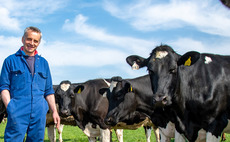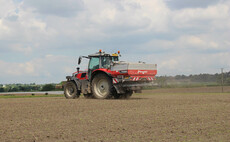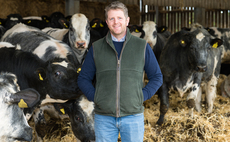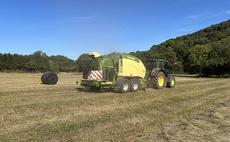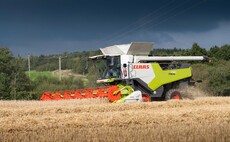
For straw and forage producer Graham Lawman, keeping ahead of hungry balers while maintaining forage quality is a priority, leading him to the purchase of a rake with a novel skid-type undercarriage. Alex Heath finds out more.
With an extensive straw and forage business, Graham and Andrew Lawman of Graham Lawman, based near Huntingdon, Cambridgeshire has recently taken delivery of a Pottinger Top 842C twin rotor rake, one of the first in the country with the manufacturer's alternative undercarriage option.
The rake is different from all others in that it uses the firm's Flowtast skid, previewed at the German Agritechnica show in 2019. Since its debut, the rake and its plastic skid has undergone testing and latterly a demonstration tour in 2020, including one on the 250-hectare Top Farm, home to Mr Lawman's business.
While the farm is home to 100 suckler cows and 350 total head of cattle reared to fat, Andrew Lawman says a large proportion of the business revolves around harvesting and supplying straw and forage crops including grass and lucerne. The workload includes baling up to 4,500ha of straw, 1,000ha of grass, half of which is silage and haylage and the other half being hay, as well as 200ha of lucerne, split between four cuts.
The workload means the windrowing equipment employed by Mr Lawman plays a pivotal role to the success of the business, especially if a wet harvest is experienced.
"The new Pottinger rake is to become our main rake. We were at capacity with its predecessor, a Top 762C, which remains in the fleet for backup. However, at five seasons old, we were considering changing it when we had the demo of the Flowtast. The new rake has a wider working width at 8.4 metres, compared to the old one that reached out to 7.5m," says Mr Lawman.
"All our raking is done ahead of square balers; we have three, 120 by 90s, one 80 by 90, and a 120 by 130. The 120 by 90s are all modern Massey Ferguson 2270s and will eat crop, but a wide twin rotor is at the top of their capacity - a four rotor is too wide.
"Most of the rake's workload is in grass, but they are also used to regather straw that has been spread when wet.
"We also have a Rieter merger for turning over wet straw swaths and rowing up lucerne. However, we have found if the lucerne is rowed up using a rake in the morning with dew still on it, the leaf remains intact and does not shatter," he adds.
Other than the increased working width the new rake offers, Mr Lawman says its increase in forward speed also helps to keep ahead of his crop hungry balers, increasing efficiency.
"With a wheeled rake, maximum speed is in the region of 15kph, depending on how rough the ground is. With the merger, we can push up to 25kph, but we are only gathering just over three metres per pass. From our experience with the Flowtast rake, it is comfortable up to 20kph, meaning it will cover significantly more than the wheeled rake each hour.
"However, at the speed it will go in heavy crops it can miss the odd bit of grass, so we may look at adding another set of tines on each arm, closer to the skid, although that is up in the air at the moment.
"We have found the balers work better behind a rake compared to the merger, and in our experience the Pottinger rakes make an even, lump-free swath, allowing the balers to keep a consistent speed," he says.
The Flowtast skid consists of five individually exchangeable 15mm thick plates, made of PE 1000 wear resistant plastic. Mr Lawman says the skids have shown very little wear between the time of the demo and subsequently returning to him when he decided to purchase the rake.
"In addition, there are no wheels to worry about getting punctures," he adds. "The mounting brackets for the skid or wheels are the same, so if we wanted to, we could replace it with wheels. I do not anticipate we will and expect a good few years out of the skid plates. The mower has 6mm metal skid plates and they rarely need replacing, so the thicker plastic, which is the same as their plough mould boards, should last equally well."
Height adjustment of the rake is manual. Mr Lawman says there is no need for electric height adjustment, with its added complexity, as operators should be getting off the seat to check the working height regardless. Mr Lawman also reports the way the new rake tracks the ground is an improvement on the wheeled version.
"We have a range of field sizes from 0.2ha up to 40 acres, but one field that is particularly challenging is 27ha of ridge and furrow. The hydraulic suspension with accumulators on the old rake did a good job of following the undulations and is the same system as the new one. However, the plastic skid wraps around the arc of the rotor, so while the tines are down and working, there is little chance of the tines catching the ground.
"We also bale 120ha of grass each year that has had the heads removed with a stripper header. It is like an arable field with tramlines, rather than a flat silage field. Because seed is taken for two years, the tramlines can become quite deep and really tests a rake out in the way it is able to contour the ground. The Flowtast manages this just fine," he adds.
The predecessor to the new rake has been a loyal servant to the business reports Mr Lawman. The only blot on its record was a small crack that occurred on the join between the main chassis and the pivot point for one of the arms. Mr Lawman say the manufacturer was quickly on the case and sent out strengthening plates and paint for the repair.
The majority of Mr Lawman's grass harvesting kit is from the Austrian manufacturer, with a Novacat A10 triple mower and Hit 10.11T tedder also used, in addition to the merger and a 10m wide Lely tedder. He reports the dealer back up and his proximity to Pottinger HQ at Corby are further reasons to take on a new product in the rake.
"So far with what we have done with the new rake, it has impressed. I have no doubts it will be a suitable replacement for our old rake which has had minimal issues, with the added benefit of better ground tracking which should lead to better quality forage, with less soil contamination and wear of tines," says Mr Lawman.

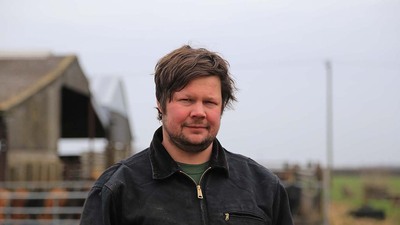
Verdict
Andrew Lawman says the rake can travel significantly quicker than a wheeled version. The Flowtast skid allows it to track the ground better, leading to less soil contamination in the forage the business produces.
In addition, the 8.4 metre working width allows more crop to be gathered ahead of the crop hungry balers he runs.
He expects to get a number of seasons out of the plastic skids which are constructed using the same polymer as the manufacturer's plastic mouldboards, with the benefit of not suffering from punctures, which small wheels seem prone to.

















